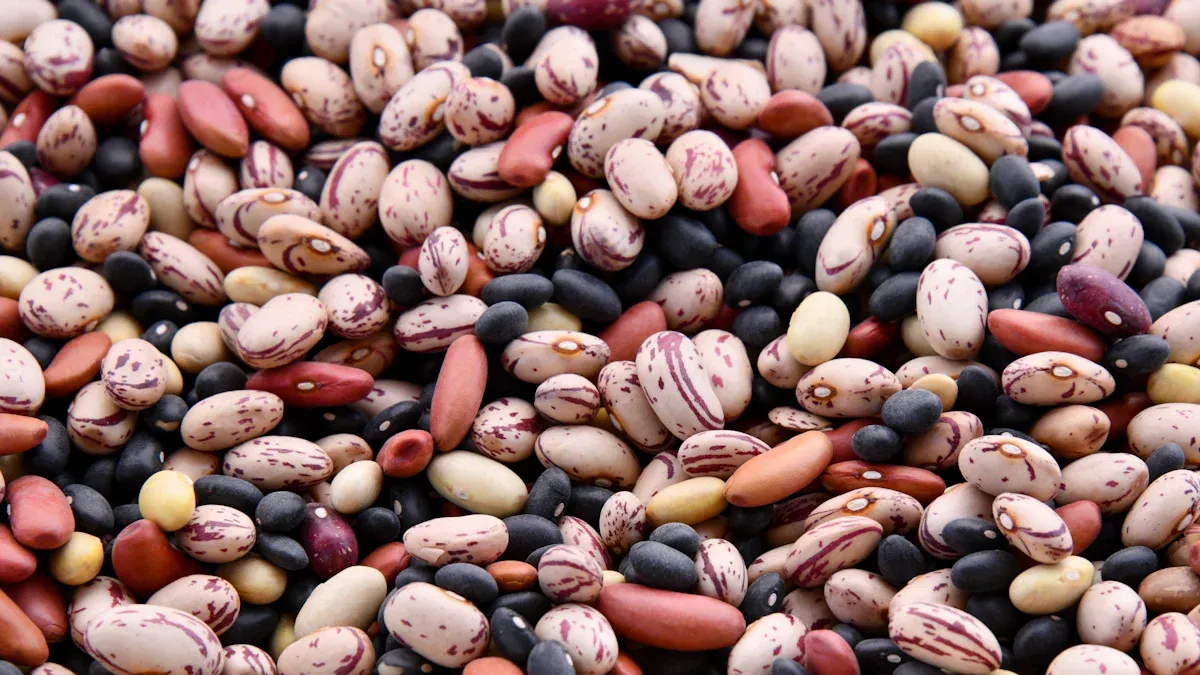
You probably want to know which beans and pulses offer the most fiber for better digestion. Here are the highest fiber beans you can add to your meals:
Navy beans – 11g per 100g
Small white beans – 10g per 100g
Adzuki beans – 7g per 100g
Split peas – 8g per 100g
Lentils – 8g per 100g
Eating these highest fiber beans gives your body a big boost in fiber, which helps keep your digestive system running smoothly and supports your overall health. Check out how much of your daily fiber you get from each option:
Bean/Pulse | Fiber per 100g | Percentage of AI |
|---|---|---|
Navy beans | 10.5 g | 31.3% |
Pinto Beans | 9 g | 26.8% |
Black beans | 8.7 g | 25.9% |
Split peas | 8.3 g | 24.7% |
Lentils | 7.9 g | 23.5% |
Mung beans | 7.6 g | 22.6% |
Adzuki beans | 7.3 g | 21.7% |
Lima Beans | 7 g | 20.8% |
Chickpeas | 6.4 g | 19% |
Kidney Beans | 6.4 g | 19% |
Soybeans | 6 g | 17.9% |
Baked beans | 4.1 g | 12.2% |
Green peas | 4.1–5.5 g | 12–16% |
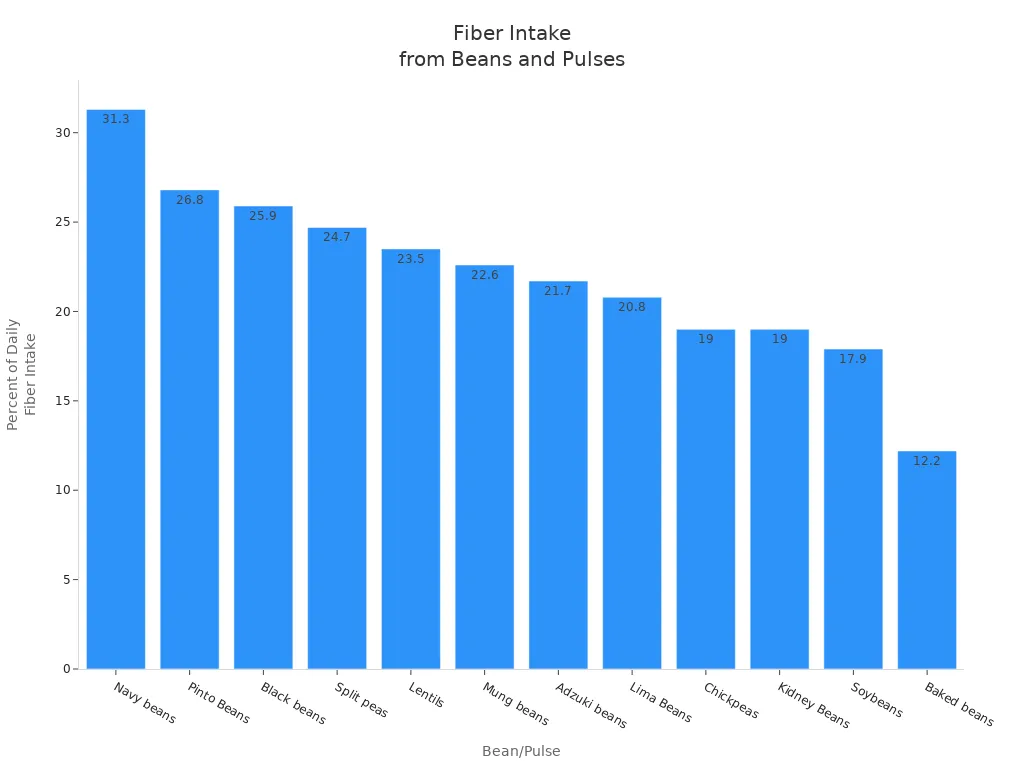
Key Takeaways
Navy beans, pinto beans, black beans, lentils, and split peas are the highest fiber beans. They help you meet daily fiber needs and support digestion.
Fiber from beans promotes gut health by feeding good bacteria. This can lead to better digestion and lower risks of metabolic diseases.
Regular consumption of high-fiber beans can lower cholesterol levels and improve heart health. Aim for at least one serving daily for maximum benefits.
Incorporate beans into meals easily. Add them to soups, salads, or wraps for a tasty way to boost fiber intake.
Start with small amounts of beans to avoid digestive discomfort. Gradually increase intake and consider soaking beans to improve digestibility.
Why Fiber Is Important
Fiber and Digestion
You need fiber for healthy digestion. When you eat beans and pulses, you get different types of fiber, such as resistant starch and galactooligosaccharides. These fibers act as prebiotic precursors. They help good bacteria grow in your gut. This process keeps your digestive system balanced and strong.
Lentils and common beans can increase the population of Akkermansia muciniphila, a helpful bacterium linked to lower rates of obesity and inflammation. This means that eating these sources of fiber can improve your gut microbiota composition.
Many scientific studies show that regular intake of beans and pulses leads to better gut health and a lower risk of metabolic diseases. You also reduce your chance of constipation when you eat enough fiber.
Fiber from beans and pulses helps prevent constipation.
You support regular bowel movements and keep your digestive tract clean.
Here is a table that summarizes how dietary fiber from beans and pulses supports digestive health:
Evidence Description | Key Findings |
|---|---|
Dietary pulses are rich in various types of fibers, including resistant starch and galactooligosaccharides. | These fibers act as prebiotic precursors, promoting the growth of beneficial gut microorganisms. |
Consumption of pulses is linked to improved gut health and reduced risk of metabolic diseases. | This includes conditions like obesity, IBD, and hypercholesterolemia. |
Regular inclusion of pulses in the diet can help achieve recommended fiber intake. | This contributes to overall digestive health and metabolic well-being. |
Other Health Benefits
You get more than just better digestion when you choose beans and pulses as sources of fiber. Fiber also helps your heart and blood sugar levels. Clinical research shows that eating 100 grams of pulses can provide up to 16 grams of fiber, which meets about 80% of your daily requirement.
Here is a chart that compares daily fiber intake recommendations for men and women across age groups:
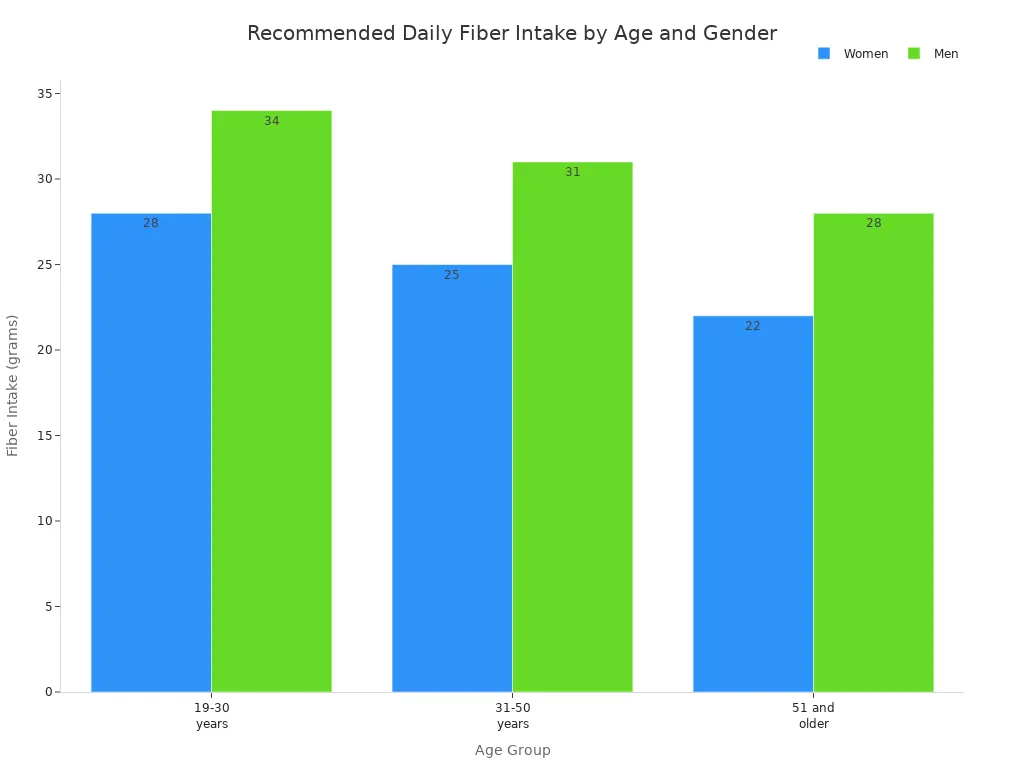
Studies show that fiber from beans and pulses can lower cholesterol levels. For example, people who ate navy beans, pinto beans, or chickpeas saw significant drops in total cholesterol and LDL cholesterol. The high water-binding capacity of dietary fiber increases stool volume, which helps prevent constipation and supports gut health.
You also benefit from better blood sugar control. Research shows that meals with beans and pulses lead to lower blood glucose responses compared to meals with white bread or rice. People who eat more pulses have lower glycated hemoglobin and a lower risk of type 2 diabetes.
Beans and pulses stand out as excellent sources of fiber. You support your digestion, heart health, and blood sugar regulation when you include them in your diet.
Highest Fiber Beans and Pulses
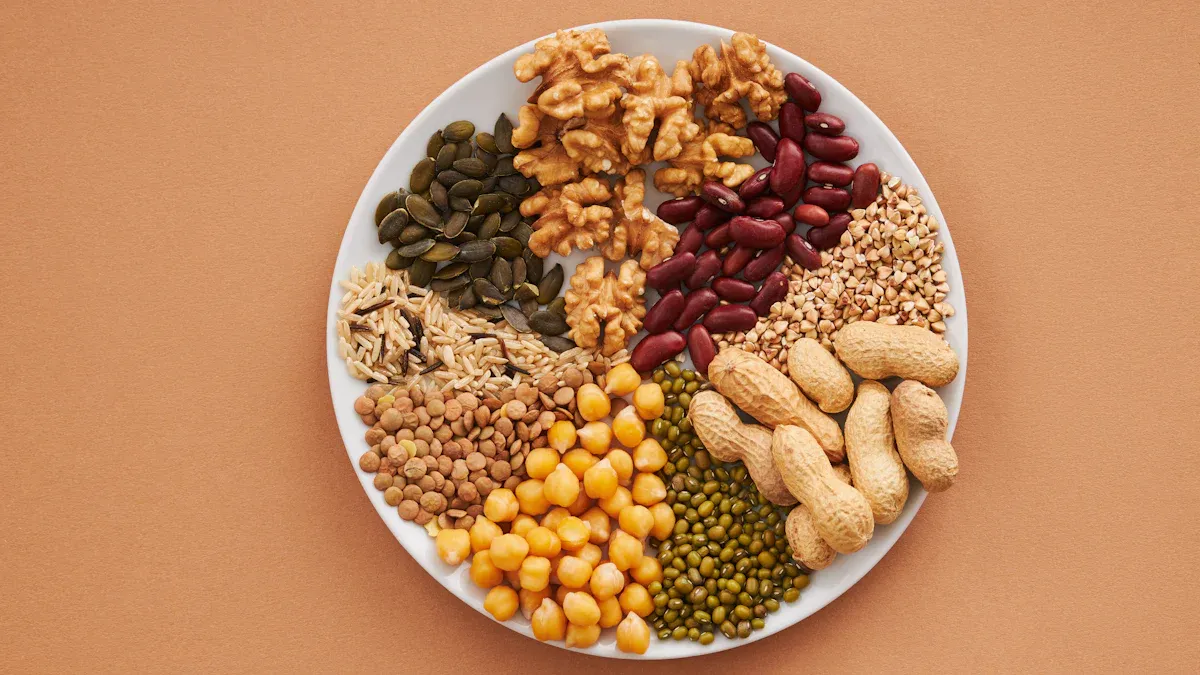
You want to know which beans and pulses are the highest fiber beans and how they help your health. Here is a breakdown of the top options and their benefits.
Navy Beans
Navy beans rank as one of the highest fiber beans. You get about 10.2 grams of fiber per serving. This makes navy beans a great choice if you want to boost your fiber intake. Navy beans contain gut-supporting fibers and amino acids that enhance gut health. Daily intake can increase microbial diversity in your gut. They also have anti-inflammatory properties that may benefit colorectal cancer survivors.
Benefit | Description |
|---|---|
Gut Health | Regular consumption improves the gut microbiome, promoting beneficial bacteria growth. |
Inflammation Reduction | Navy beans help regulate inflammatory markers, which is crucial for colorectal cancer survivors. |
Cancer Prevention | Increased intake is linked to reduced risk of colorectal adenoma recurrence. |
Cholesterol Levels | Navy beans lower total serum cholesterol levels in adults. |
You support your digestive system and heart health when you eat navy beans.
Lentils
Lentils are high in fiber, with cooked lentils providing about 7.4 to 8 grams of fiber per 100 grams. Lentils help maintain digestive tract health by preventing constipation and promoting regular bowel movements. They contain prebiotic carbohydrates that support a healthy gut microbial ecosystem. Lentils also have anti-inflammatory properties, which can help reduce inflammation in your body.
Lentils provide 12–14 grams of prebiotic carbohydrates per 100 grams of dry lentils.
Lentils inhibit enzymes that induce inflammation, supporting gut and overall health.
You can add lentils to soups, salads, or stews for a simple way to increase your fiber intake.
Black Beans
Black beans are another high fiber option. One cup (185g) of cooked black beans contains 15 grams of fiber. If you use canned black beans, half a cup (120g) gives you 8.3 grams of fiber. Black beans support cardiovascular health. Studies show that eating black beans can decrease blood pressure and LDL cholesterol levels. Darker beans like black beans improve vascular tone and lipid profiles more than lighter beans.
Serving Size | Fiber Content |
|---|---|
1 cup (185g) cooked black beans | 15 g |
1/2 cup (120g) canned black beans | 8.3 g |
Study Title | Findings |
|---|---|
Black beans and red kidney beans induce positive postprandial vascular responses in healthy adults | Improved vascular function due to fiber and polyphenols. |
Legume-derived bioactive peptides: role in cardiovascular disease prevention and control | Black beans reduced blood pressure and LDL cholesterol. |
Beans consumption can contribute to the prevention of cardiovascular disease | Darker beans improved vascular tone and lipid profiles. |
You can use black beans in burritos, salads, or chili to get more fiber and support your heart.
Chickpeas
Chickpeas are high in fiber, with 7.6 grams per 100 grams. Chickpeas help you feel full after eating. Research shows that chickpeas suppress appetite and reduce energy intake at the next meal. Regular consumption may help with weight management and blood sugar control.
Nutrient | Amount per 100g |
|---|---|
Dietary Fiber | 7.6g |
Study Focus | Findings |
|---|---|
Chickpeas and Appetite | Suppress postprandial blood glucose and appetite. |
Satiety Mechanism | Improve blood glucose control and appetite suppression. |
Long-term Impact | May contribute to weight loss through appetite management. |
You can add chickpeas to salads, hummus, or stews for a tasty way to increase fiber.
Pinto Beans
Pinto beans are one of the highest fiber beans, with 9 grams per serving. One cup (171 grams) of boiled pinto beans provides 40–60% of the Daily Value for fiber. Pinto beans contain high levels of resistant starch, which act as substrates for bacterial fermentation. This process generates short-chain fatty acids, especially butyrate, which protect against cancer and improve gut health. Subjects consuming pinto bean flour showed higher propionate levels, which are linked to lower cholesterol.
Nutrient | Amount |
|---|---|
Dietary Fiber | 9g |
Evidence Description | Findings | Source |
|---|---|---|
Resistant starch in pinto beans | Generates SCFAs, especially butyrate, for anti-cancer protection and gut health | MDPI |
Pinto bean flour consumption | Higher propionate levels, lower cholesterol | MDPI |
Beans in diet | Higher butyrate levels, lower cancer risks, improved digestive health | MDPI |
You can use pinto beans in chili, burritos, or as a side dish to boost your fiber intake.
Other Healthy Beans
Many other legumes are high in fiber and offer great health benefits. Here is a table comparing the fiber content of some of the highest fiber beans:
Bean Type | Fiber Content (grams) | Source Link |
|---|---|---|
Lentils | 15.6 | Link |
Kidney Beans | 13.1 | Link |
Black Beans | 15 | Link |
Pinto Beans | 15.4 | Link |
Navy Beans | 19.1 | Link |
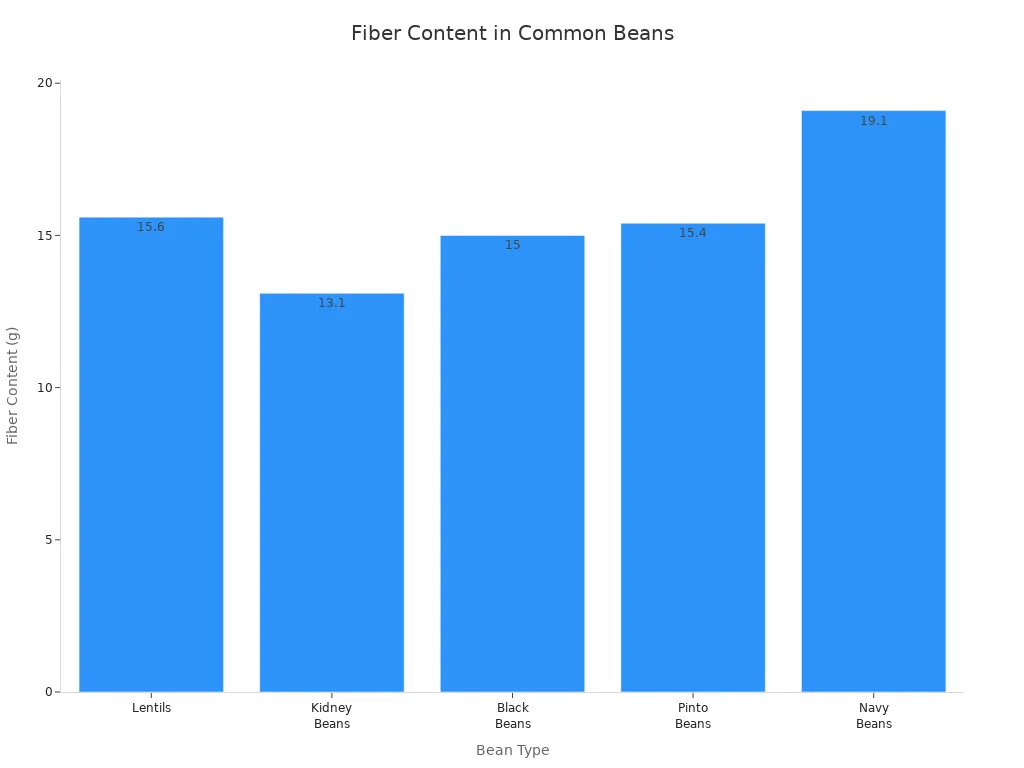
You can choose from many healthy beans and legumes to meet your fiber needs. These options are high in fiber and support digestive health, heart health, and weight management. Add them to your meals for a simple way to improve your diet.
Healthiest Beans for a Healthy Diet
Nutritional Value
You want to choose the healthiest beans for your meals. These beans stand out because they pack a lot of nutrients into every serving. Most legumes give you protein, fiber, magnesium, and folate. You get vitamins and minerals that help your body work well. If you pick plain beans, like dried or unflavored canned beans, you avoid extra sugars and salts. This makes your meals better for your health.
Tip: Limit beans with added sugar or salt, such as baked or refried beans. Choose plain legumes for the best results.
Protein and Low Fat
Beans and legumes give you a strong source of plant-based protein. You get less saturated fat and cholesterol than you would from animal proteins. This helps your heart and keeps your energy steady. Most beans provide between 29% and 36% of your daily protein needs per cooked cup. Boiled soybeans offer even more, reaching 63% of your daily value.
Bean Type | Protein Content (DV per cup cooked) |
|---|---|
Most Beans | 29% – 36% |
Boiled Soybeans | 63% |
You can rely on legumes for protein while keeping your meals low in fat.
Heart and Gut Health
Eating the healthiest beans supports your heart and gut health. The fiber in legumes binds to bile acids and helps lower cholesterol. Studies show that people who eat half a cup of cooked beans daily see a drop in cholesterol levels. You also help your gut health by feeding good bacteria with the fiber found in legumes. This keeps your digestive system strong and balanced.
You can add legumes to salads, soups, or grain bowls. You get more fiber, better gut health, and a heart-friendly boost. The healthiest beans make it easy to build a healthy diet.
Easy Ways to Add Healthy Beans to Meals
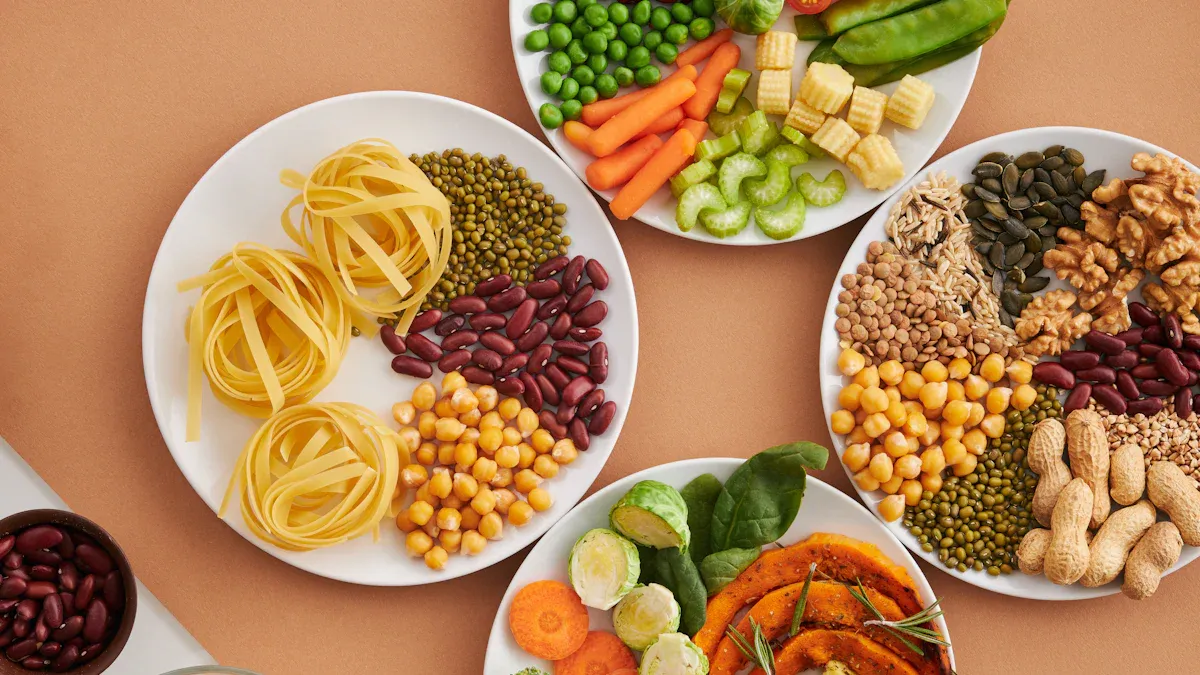
Simple Meal Ideas
You can add beans and legumes to many meals without much effort. Nutritionists recommend several easy ways to boost your fiber intake:
Toss beans into soups, salads, or casseroles for extra fiber.
Replace half the meat in chili with beans for a plant-based source of protein.
Mix beans into salsas or purée them for a gut-friendly side dish.
Add beans to wraps, pastas, or grain bowls to support your microbiome.
Pair beans with vegetables at every meal to create a fiber-rich diet.
Here are some simple recipes that maximize fiber:
Start your morning with beans on whole grain toast or potatoes.
Enjoy chips and homemade bean dip as a snack.
Blend cooked beans or lentils into a spread for sandwiches.
Build a bowl with whole grains, legumes, and veggies.
Make hummus using beans for a savory snack.
Add beans to salads and wraps for lunch.
Tip: You can use canned beans for convenience. Rinse them to reduce sodium.
Cooking Tips
You can prepare beans and legumes in ways that keep them tasty and easy to digest. Soak dried beans for 1-3 hours before cooking. This step can cut oligosaccharides by half, making beans easier on your stomach. Change the soaking and cooking water to lower oligosaccharide content even more. Cook beans until they are soft to help your body absorb fiber and nutrients.
Cooking Strategy | Benefit |
|---|---|
Soak beans before cooking | Reduces oligosaccharides by up to 50% |
Change cooking water | Lowers oligosaccharides by 25-85% |
Cook beans until soft | Improves digestibility and nutrient absorption |
Rinse canned beans | Removes excess sodium |
Note: Lentils and black-eyed peas are often easier to digest than other legumes.
Reducing Digestive Discomfort
You may notice gas or bloating when you eat more fiber from beans. You can reduce discomfort by choosing beans with fewer oligosaccharides, such as lentils. Introduce beans slowly into your diet to let your microbiome adjust. If you still feel discomfort, try a digestive enzyme like alpha-galactosidase with meals.
Soak beans before cooking to lower compounds that cause gas.
Change out the cooking water for even better results.
Add beans gradually to prevent constipation and bloating.
Strategy | Description |
|---|---|
Choose lower oligosaccharide beans | Select beans that are easier to digest, like lentils or black-eyed peas. |
Soak beans before cooking | Soaking helps reduce compounds that cause digestive issues. |
Change out the cooking water | Replacing water lowers oligosaccharide content. |
Introduce beans slowly | Gradual increase helps your digestive system adapt. |
Consider digestive enzymes | Enzymes can help break down fiber and reduce gas. |
If you experience discomfort, try different types of legumes or use digestive enzymes to support your gut-friendly diet.
You gain many health benefits when you eat high-fiber beans and pulses. These foods help lower cholesterol, reduce heart disease risk, and support better digestion.
Bean Type | Fiber Content (g per ½ cup) |
|---|---|
Kidney Beans | 5.7 |
Pinto Beans | 7.7 |
Navy Beans | 9.5 |
Eating legumes four times a week links to a 14% lower risk of coronary artery disease.
One to two servings daily may lower cancer mortality by 29%.
Beans and pulses provide fiber, potassium, magnesium, and iron for digestive health.
You can easily add beans to soups, salads, or wraps. Simple changes help you reach your fiber goals and improve your overall health.
FAQ
What are the best beans for fiber?
You get the most fiber from navy beans, pinto beans, black beans, lentils, and split peas. These beans help you meet your daily fiber needs and support your digestive health.
What happens if you eat too many beans?
You may feel bloated or gassy if you eat too many beans at once. Start with small amounts. Let your body adjust. Drink water to help your digestion.
What is the easiest bean to digest?
Lentils and black-eyed peas are easier to digest than other beans. Soaking and cooking beans well also helps reduce digestive discomfort.
What is the daily fiber goal for most people?
Most adults need 25–30 grams of fiber each day. You can reach this goal by eating beans, whole grains, fruits, and vegetables.
What is the best way to add beans to your meals?
Try adding beans to salads, soups, or wraps. You can blend beans into dips or spreads. Use canned beans for quick meals. Rinse them to lower sodium.


